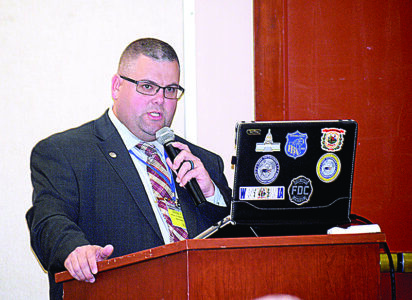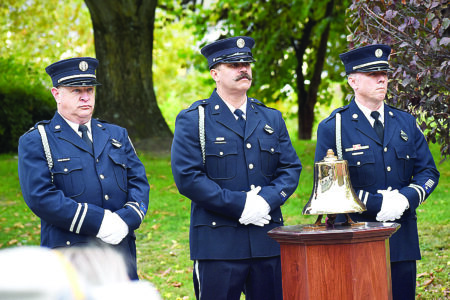Renovated Howgait Manor, a Glimpse Into Wheeling’s Past, Is on the Market

Owner Jon Ren has spent the last 12 years restoring Howgait Manor since purchasing the estate, and has put the property back on the market. (Photo Provided)
WHEELING — Tucked just off Bethany Pike sits a piece of a bygone era, as the four-acre Howgait Manor has been restored into a replica of its original 1900 form.
Spanning four acres, the sprawling nine-bedroom, four-bathroom house has become a pocket of the Victorian era in Wheeling, with owner Jon Ren spending the last 12 years repairing the manor.
Howgait was created by Wheeling philanthropist George Laughlin, with every piece, from marble pillars to stained glass windows, made on-site as it was built. First named Anna’s Knoll after the first owner’s wife, Anna Laughlin, the name of the house was changed to Howgait Manor after the next set of owners, William and Margaret Holloway, modified the title to their namesake.
In the 1950s, the manor and its corresponding carriage house were subdivided into apartments, leading to the original woodwork in the house being torn apart to create more rooms.
Howgait remained separated into apartments until ownership passed over to Ren in 2011. Since purchasing, Ren has transformed the house as close as he can get it to its original form.
While walking through the breakfast room of Howgait, Ren pointed out a Pilotuner Radio installed in a china cabinet as one of the original pieces preserved. He added the radio was one of the first wall stereos ever used in the city.
Other eras are also contained in the manor, as gas furnaces from the 1950s remain on the walls of the carriage house, now a pink paint coat added to them.
This painting was done by Ren, who has added multiple other “fresh coats” to areas of the house since purchasing while also “chipping away” at other areas to reveal the original work that had been covered.
“I’ve had to tear away lots of yellow wallpaper,” said Ren, who added he had to rip off six layers of wallpaper to get to the original walls in the kitchen.
Estimating that “about 99%” of the original pine flooring has now been uncovered, Ren described peeling back linoleum and scrapping off glue from the kitchen floor to reveal the original wood.
Apart from tearing away, Ren explained he often finds himself digging up pieces discarded of the original manor to add back to the estate.
On the stairwell leading to the second floor of the house, large glass windows have been added to provide a view of the carriage house. The windows were once two closets that separated apartments. Ren explained the original woodwork in the house had to be torn away in the 1950s to create separate rooms.

The elegant interior of Howgait Manor, built by philanthropist George Laughlin in 1900, has been restored by current owner Jon Ren, who acquired the property in 2011 and recently put it back on the market. (Photo Provided)
Ren found the panes of the windows in the basement of Howgait and then decided to place them back on the house. The owner added he is unsure whether the stained-glass crest decorating the pieces belongs to the Laughlin or Holloway family.
While the panes for the windows could be found in the basement, Ren had to find someone to replicate the ornate original woodwork surrounding them, seeking out Kline Lumber in Ohio for the job. The company was able to match the original wood through samples exactly.
Since many original house pieces had to be replicated, Ren explained he is glad whenever he uncovers an original aspect of the manor that has remained untouched over the decades.
Pointing out a buzzer on a wall in a hallway, Ren detailed that Laughlin or Howgait would have used it to call servants. He noted there was also a window left behind in the kitchen that would have been used by servants to pass food from the kitchen to the dining room.
A feature of the house that encompasses both the restoration and preservation required to bring Howgait to its current state is the elevator, which travels all four floors. Built in 1900, a motor was added to the elevator’s machinery in the 1950s.
Since the elevator was in disrepair when Ren bought the house, the process of getting it up and running again was an in-depth one. The owner described being unable to find a replacement motor, forcing him to hire someone to build a restored motor that replicates how the elevator would have functioned in the 1950s.
“Everything’s out there, and if it’s not out there, someone can build it,” added Ren. “The internet also helps a lot.”
Opening up a cupboard next to the elevator to reveal a hose bib installed inside, Ren explained that some of the quirks of the original owner are still contained in the house’s walls.
“I don’t know if Laughlin was afraid of his house burning down, but he had a fire hose on each floor put in,” said Ren. “I’m not sure why he had to worry about that because many of the interior walls are two-course brick all the way up, making it a really solid house.”
While Laughlin’s hoses are gone, the solid structure of the house remains, with Ren lamenting that nowadays, houses often aren’t built with the same structural integrity as those in the early 1900s.
“Houses aren’t built like this anymore, and it’s unfortunate because places like Howgait can last forever if you care for them,” said Ren. “The materials we use today just aren’t what they used back then.”
While the structure is strong, Ren noted that “a lot of maintenance” still has to be performed due to the age of the house. The owner explained he had to add all new roofs, waterproofing and water lines.
There are some modern-day amenities the owner specifically decided not to include in the house, such as a central heating and cooling unit. For Ren, preserving the original ceiling and plasterwork by not having to run any ductwork was more important than A/C.
“It usually doesn’t get that hot around here in the summer anyways,” joked Ren.
Adding that Victorian and Tudor-type houses were designed in a “mazelike way” where rooms are interconnected, Ren noted this was intentionally done to increase airflow throughout the home. This design feature helps keep Howgait cool in the summer.
“When you put it all together, it’s like you’re going back in time when you step in here,” said Ren. “I loved living here with my family because it felt like we were in our little pocket away from the rest of the world.”
The owner is proud of the restoration work he has done to keep Howgait this “little pocket” separated from the world, adding that it was sometimes difficult to take a step back and enjoy his work as his head was “always down in a project.”
Now, with his daughters away at college, Ren wants to downsize, with Howgait going on the market on Oct. 13. Since its listing, the owner has been doing six to eight tours a day with potential buyers from across the country.
“When you’re deep in it fixing a house, all you see is everything that needs to be done, how much money it will cost and all the years and years of work it will take,” said Ren. “For me, this last year, it’s been like 12-hour days working, but it’s really paid off to see everybody’s reaction.”
While Ren begins restoring his new house to its original 1950s mid-century modern style, he joked he hopes there is not as much wallpaper on those walls to peel off.



